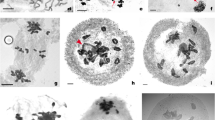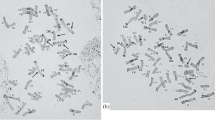Abstract
Meiotic chromosome cytology was compared betweenSolanum pennellii, Lycopersicon esculentum, and the F1 hybrid. Pachytene chromosomes are very similar in gross morphology, but several of theS. pennellii chromosomes were found to have somewhat longer chromatic regions with discrete chromomeres, and darkly staining chromomeres in the achromatic regions.
Little evidence could be found for the existence of rearrangements between chromosomes of the two species. With respect to chromomere pattern, on the other hand, a number of differences were seen. Meiosis in the hybrid is strictly regular. Only size inequalities occur in certain bivalents.
Considering the evidence from chromosome pairing, hybridization compatibility, hybrid fertility, and plant morphology, it is concluded that the phylogenetic relationship is much closer betweenS. pennellii andL. esculentum than it is between either one andS. lycopersicoides. Attention is called to the present unsatisfactory placement ofS. pennellii and to the need for revising the taxonomy to place it andL. esculentum in the same genus, possibly in the same subgeneric category.
Similar content being viewed by others
References
Andersen, W. R. (1963). Cytoplasmic sterility in hybrids ofLycopersicon esculentum andSolanum pennellii.Rept. Tomato Genetics Cooperative 13: 7–8.
Barton, D. W. (1950). Pachytene morphology of the tomato chromosome complement.Amer. Jour. Jour. Botany 37: 639–643.
Brown, S. W. (1949). The structure and meiotic behavior of the differentiated chromosomes of tomato.Genetics 34: 437–461.
Correll, D. S. (1958). A new species and some nomenclatorial changes inSolanum, sectionTuberarium.Madroño 14: 232–236.
Gottschalk, W. &N. Peters (1956). Das Konjugationsverhalten partiell homologer Chromosomen.Chromosoma 7: 708–725.
Hardon, J. J. (1962). Self-incompatibility and self-compatibility inSolanum pennellii Cor. in relation to its unilateral compatibility withLycopersicon esculentum Mill.Rec. Genetics Soc. Am. 31: 88.
Menzel, M. Y. (1962). Pachytene chromosomes of the intergeneric hybridLycopersicon esculentum x Solanum lycopersicoides.Amer. Jour. Botany 49: 605–615.
Rick, C. M. (1951). Hybrids betweenLycopersicon esculentum Mill. andSolanum lycopersicoides Dun.Proc. Nat. Acad. Sci., U.S.A. 37: 741–744.
Rick, C. M. (1960). Hybridization betweenLycopersicon esculentum andSolanum pennellii: phylogenetic and cytogenetic significance.Proc. Nat. Acad. Sci., U.S.A. 46: 78–82.
Rick, C. M. &G. S. Khush (1962). Preferential pairing in tetraploid tomato species hybrids.Rec. Genetics.Soc. Am. 31: 110–111.
Swaminathan, M. S., M. L. Magoon &K. L. Mehra (1954). A simple propioniccarmine PMC smear method for plants with small chromosomes.Ind. Jour. Genetics and Plant Breeding 14: 87–88.
Author information
Authors and Affiliations
Additional information
This research was supported in part by grant G-10704 of the National Science Foundation.
Rights and permissions
About this article
Cite this article
Khush, G.S., Rick, C.M. Meiosis in hybrids betweenLycopersicon esculentum andSolanum pennellii . Genetica 33, 167–183 (1963). https://doi.org/10.1007/BF01725760
Received:
Issue Date:
DOI: https://doi.org/10.1007/BF01725760




